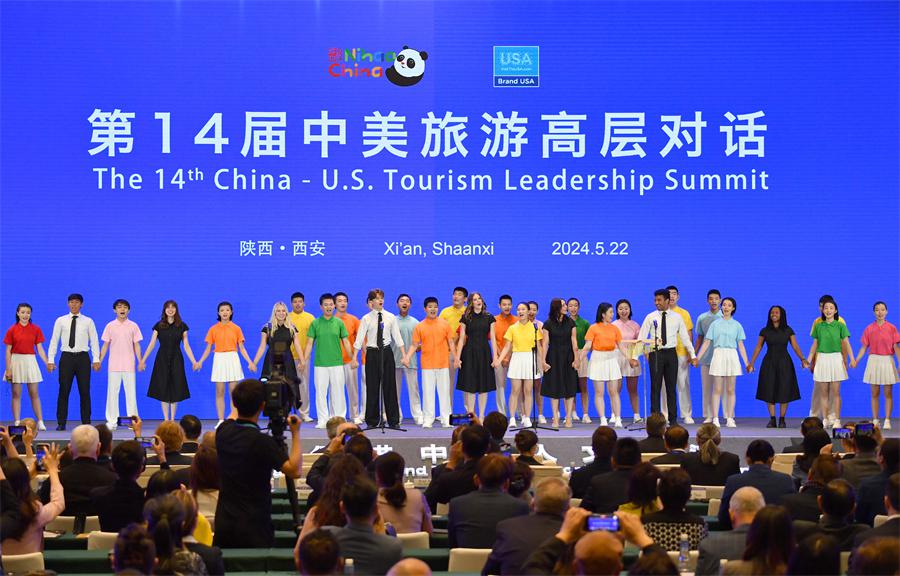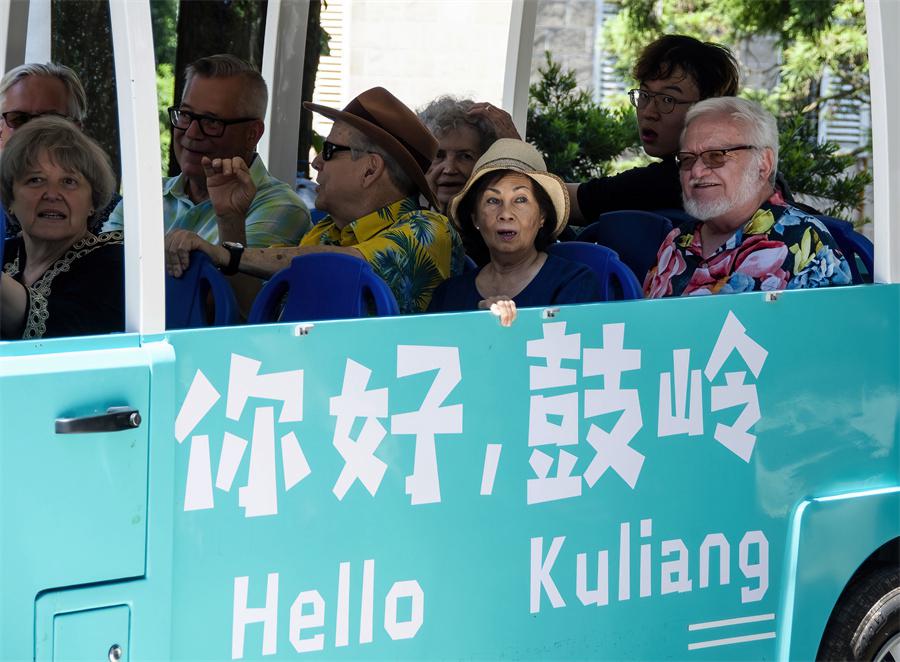
Chinese and the United States students perform at the opening ceremony of the 14th China-US Tourism Leadership Summit in Xi'an, Shaanxi province, in May. The event was held to expand China-US travel and people-to-people exchanges. [Photo/Xinhua]
This year has seen China and the United States make measured efforts to stabilize relations after their presidents reset the bilateral dynamic at a summit in late 2023. That stabilization, however fragile or fruitful, may face daunting challenges in 2025, with some analysts saying it is a matter of hoping for the best, but preparing for the worst.
The China-US relationship, after going through ups and downs over the past four years, has remained "stable on the whole", President Xi Jinping told US President Joe Biden in Lima, Peru, on Nov 16, a year after they met in San Francisco, where they both stated a willingness to achieve a relaxation of tensions.
At the Lima summit, Biden reiterated his government's stance that it does not support "Taiwan independence", its alliances are not targeted at China, and it does not seek conflict with China.
He also lauded the "tangible progress" Beijing and Washington have made in military-to-military relations, counternarcotics, law enforcement, artificial intelligence, climate change and people-to-people exchanges.
But in action, the Biden administration has approved a litany of arms sales, or potential ones, to Taiwan in recent months, ranging in value from $200 million to $2 billion.
Biden's top diplomat, Secretary of State Antony Blinken, said on Dec 18 that China's "complaining" about Washington's efforts to "bring these other countries into some kind of alliance against China… is the most powerful evidence of the success that we've had".
On the economic front, the outgoing Biden administration this month alone decided to raise tariffs on solar wafers, polysilicon and some tungsten products from China, and, in the third round of sweeping technology restrictions in three years on Chinese companies, it placed nearly 140 more on its Entity List for national security concerns, a move that China said overstretches the national security concept.

Foreign guests take a sightseeing tour in Kuliang, Fuzhou, Fujian province, in June. Since 1886, people from countries including the US, the United Kingdom and France, have built summer villas in Kuliang, fostering harmony with locals. [Photo/Xinhua]
Return of Trump
Further complicating the situation is the transition to a new US administration in 2025 under Donald Trump, whose previous presidency heightened tensions between the two powers.
"The United States is engaged in economic warfare against China, and China is now firing back," said Chas Freeman, former US assistant secretary of defense for international security affairs. "The incoming Trump administration promises to escalate rather than lower tensions and appears to harbor unrealistic expectations that, by increasing the pressure on the Chinese economy, it can once again put together a one-sided deal with China," Freeman told China Daily.

US citizens try using chopsticks at an International Chinese Language Day event at the Chinese Embassy in Washington, DC. [Photo/Xinhua]
Commenting on Trump's history of deal making and unpredictability, Freeman said he believes Trump is capable of grand gestures, and is willing to take political risks in the interest of solving problems.
"We must hope that he will do so to calm Sino-American relations and put them back on a mutually beneficial track," Freeman said. "We should hope for the best but prepare for the worst."
Freeman, the chief US interpreter during president Richard Nixon's 1972 visit to China, said there "certainly" are areas or sectors where cooperation between China and the US is still viable.
But discovering these will require the two sides to re-engage and once again explore the respective interpretations of global and regional trends and events, he said.
"We each have enormous influence internationally, and we both recognize that our bilateral relationship can be either a force for problem-solving or a barrier to addressing issues of concern, not just to us but to all mankind.
"With the backing of our respective leaders, I am confident that we can yet muster the diplomatic skill to manage a rapprochement like that we began half a century ago," Freeman said.
While "stabilization" has been high on each government's agenda, the state of US-China relations is not static, with uncertainties and headwinds looming, other experts said.
"The most important source of stabilization has been the expansion of dialogue — official and unofficial — during the past 18 months. The two sides have a clearer sense of the other's intentions and the content of their policies, and the number of policy 'surprises' has dropped dramatically," said Scott Kennedy from the Center for Strategic and International Studies in Washington.

A US student performs ethnic singing and dancing with local youth in Xijiang Qianhu Miao Village, Guizhou province, on Sept 9. [Photo/Xinhua]
"There is substantial competition across economic, security and diplomatic domains. That said, there are still some areas of cooperation. The commercial and scholarly relationships are still broad and deep, and the two sides have avoided outright military conflict and decoupling. Nevertheless, the status quo is not static, and relations are on a gradual downward trajectory," Kennedy told China Daily.
A senior adviser and trustee chair in Chinese business and economics at CSIS, Kennedy said the Trump administration's China policy is hard to predict.
"Does the Trump administration seek a grand bargain with China to stabilize ties further, or does it see China as a rival who it needs to contain and weaken? You see potential signs of both," he said.
Douglas H. Paal, distinguished fellow in the Asia program at the Carnegie Endowment for International Peace, cautioned that stability is not on solid ground, largely due to the entrenched mistrust between the two countries.
"Both sides have addressed thorny issues, with leadership endorsement, through working groups that bring what I agree is 'stabilization' compared to the recent past, but not an enduring stability," he said in an email interview.
"The key risks are in misreading the other's intentions and capabilities," he added.
Paal listed progress that occurred on precursors for illicit fentanyl drugs, prosecution of illegal traffickers, release of detainees and prisoners, restored military communications, the conditional renewal of the Science and Technology agreement, as well as modest cooperation on relief of less-developed nations' debt, and travel and visas.

Visitors pose for a photo during the Open Day of the Chinese Embassy in Washington, DC in May. [Photo/Xinhua]
Strategic communication
Throughout 2024, under the guidance of head-of-state diplomacy, Beijing and Washington held two rounds of strategic communication, and five meetings of the Financial Working Group and the Economic Working Group.
They also co-signed each other's resolution on artificial intelligence at the United Nations General Assembly, feats that show that as long as China and the US cooperate with each other, they can accomplish many great things together, China's Foreign Minister Wang Yi said on Dec 17 in Beijing.
Paal said it is difficult to forecast a likely trajectory for China-US relations in 2025, given the differing priorities of the people Trump is assembling for his administration.
He said cultural exchanges and management of trade issues will be the most likely areas of rapprochement, with cooperation being hard, but it could come in public health, environmental protection, space exploration, and other public goods.
Gary Hufbauer, a senior fellow at the Peterson Institute for International Economics in Washington, cautioned that relations could get "a lot worse" if Trump imposes 60 percent tariffs on all imports from China (plus 100 percent on electric vehicles), and both countries ramp up military engagement.
"Right now, mistrust is extremely high. The way out requires some reduction of tariffs and export controls by both countries, plus a major exchange of sporting and cultural events," Hufbauer said.
The trade expert also noted that China is making good progress on controlling CO2 emissions. Trump doesn't believe in climate change, but many Americans see the danger.
"If China could assist developing countries to build renewable energy plants, that would be a plus. On the diplomatic front, China and the US could cooperate in seeking a de-escalation of military confrontation in the Middle East," he added.
David J. Firestein, another veteran China hand, noted that bilateral efforts to stabilize the relationship have borne some fruit, but with the return of Trump to the White House, the two countries are at an "inflection point".
Firestein, the inaugural president and CEO of the George H.W. Bush Foundation for US-China Relations, said that the two countries can learn from the success of coming together, working together, and dealing with each other in a "respectful and businesslike way" — there are areas where they benefit from doing so.
"It's not altruism, it's not charity, it's self-interest that dictates that that's a good thing to do," Firestein told China Daily.

A US student experiences Qixi traditions during a cultural event at a high school in Shijiazhuang, Hebei province, in August. [Photo/Xinhua]
Tough moments expected
Looking forward to 2025, Firestein said he expected to see some "tough moments" in the relationship.
"My cautious hope is that things don't get appreciably worse, and I think we can achieve that with wise leadership on both sides," he said.
Firestein's sentiment was echoed at a seminar in Washington, DC, held by the Institute for China-US Studies on Dec 17, at which one of the keynote speakers cautioned all onboard the China-US relations journey to "buckle your seat belt" — hoping for the best, preparing for the worst.
In his talks, Steve Orlins, president of the National Committee on United States-China Relations, listed "real positive" things that happened this year such as reopened channels of communications, the lowering of the travel advisory from three to two, and increasing cooperation on fentanyl.
"When you have channels of communication, you can still find places to cooperate. And that was kind of the positive, and that's a view that maybe we'll talk about, that maybe president-elect Trump… and his team will seek to follow that path," he said.
Orlins said what is clear from Trump's first term is that tariffs did not bring jobs back to the US. They diverted manufacturing to other countries, but the companies didn't come back here, he said.
He also said there was "a securitization of everything" and, a simple definition of national security was needed "that will allow for manufacturing to come to the United States. It will allow us to export more to China than we do."
Orlins also proposed making clear what is white-listed, gray-listed, and black-listed, and having clear end-use certifications.
"There's so many interesting things that president-elect Trump's team can do that… the 'small yard and the high fence' didn't allow the US and China to do during the Biden administration," Orlins said.
-
Beijing, Tokyo chart relations during talks
Beijing, Tokyo chart relations during talks
-
Role in global poverty fight wins praise
Role in global poverty fight wins praise
-
Favorable measures propel surge of foreign tourists
Favorable measures propel surge of foreign tourists
-
Japanese youths cherish visitsmade to China
Japanese youths cherish visitsmade to China